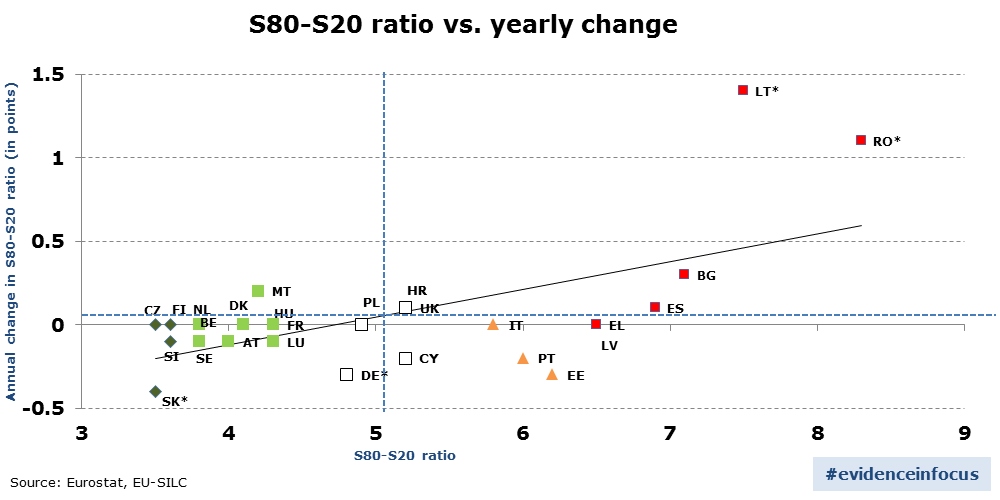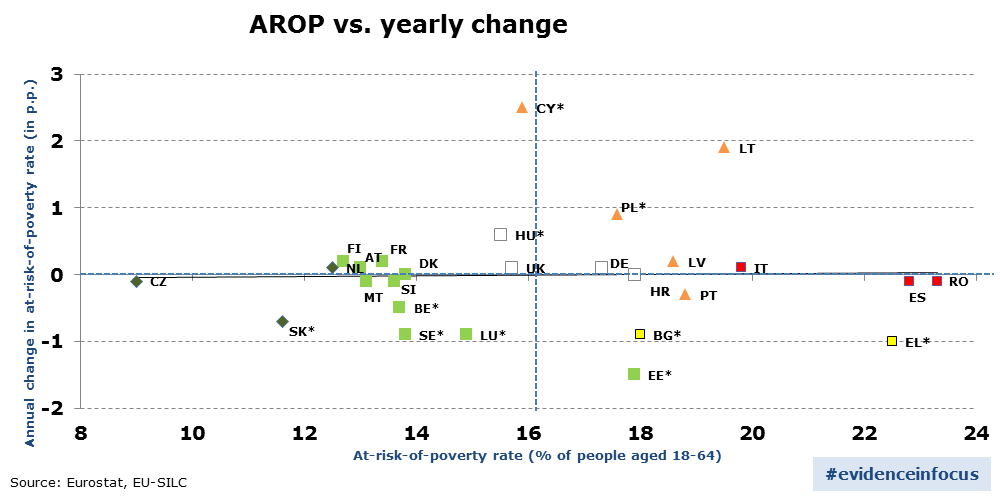Inequality and poverty – what action is being taken by Member States?
(From ec.europa.eu)
The 2017 Joint Employment Report (JER) and its Scoreboard of Key Employment and Social Indicators, adopted on 3 March 2017, provide a snapshot of recent employment and social policies implemented in Member States in line with the Employment Guidelines.
Exploring the Joint Employment Report, this edition of Evidence in focus looks at income inequality and poverty developments, and the policy efforts that have been made to reduce them.
Overall, the highest income inequalities are observed in Romania, Lithuania, Bulgaria, Spain, Latvia and Greece. The changes in inequality show a diverging trend. Inequality intensified in Lithuania (by 1.4 pp) and Romania (by 1.1 pp), while the largest declines were registered in Slovakia (by 0.4 pp) and Germany (by 0.3 pp). Thus, some of the Member States with the highest inequality levels also are likely to experience larger increases.
This is shown in the graph below. The horizontal axis of Figure 1 shows income inequality in the EU Member States in 2015. Inequality is measured by the ratio of the income (after taxes and social transfers) held by the 20% share of the population with the highest incomes to the income held by the 20% with lowest incomes. The vertical axis shows the change in income inequality observed between 2014 and 2015.
Figure 1:
 Note: Note: no data available for Ireland (16th January 2017). Axes are centred on the unweighted EU average. The legend is presented in the Annex 4 of the JER. Countries with a statistically significant change in S80/S20 are marked with a star (*).
Note: Note: no data available for Ireland (16th January 2017). Axes are centred on the unweighted EU average. The legend is presented in the Annex 4 of the JER. Countries with a statistically significant change in S80/S20 are marked with a star (*).
Figure 2 shows that the highest at-risk-of-poverty (AROP) rates for working age population are found in Romania, Spain and Greece, followed by Lithuania, Latvia and Italy. Twelve Member States experienced an increase in the rates in the age group 18-64 between 2014 and 2015. The AROP rate increased noticeably in Cyprus (by 2.5 pp) and Poland (by 0.9 pp). Some Member States saw important reductions, in particular Estonia (by 1.5 pp), Greece (by 1 pp), and Bulgaria (0.9 pp). The highest poverty rates for the working age population (close to or higher than 20%) were registered in Romania, Spain and Greece.
Figure 2:
 Note: Note: no data available for Ireland (16th January 2017). Axes are centred on the unweighted EU average. The legend is presented in the Annex 4 of the JER. Countries with a statistically significant change in AROP are marked with a star (*).
Note: Note: no data available for Ireland (16th January 2017). Axes are centred on the unweighted EU average. The legend is presented in the Annex 4 of the JER. Countries with a statistically significant change in AROP are marked with a star (*).
Tackling income inequality and poverty requires efforts in multiple directions: modernising social protection systems to improve coverage and adequacy of benefits, as well as access, quality and responsiveness of services; tackling tax evasion and improving the effectiveness of tax and benefits systems in their redistributive function; improving the functioning of labour markets to support the (re)integration of those in working age and wage setting mechanisms (including the minimum wage) that ensure adequate living standards while promoting competitiveness and ensuring access to quality education, adult learning and healthcare systems.
As shown in the JER, in 2016 Member States took action to address the issues of income inequality and poverty. Examples of ongoing reforms included:
- Improving coverage and adequacy of social benefits while enhancing activation, in line with the Active Inclusion principles (e.g. in Estonia, Italy, France, Croatia, Denmark, Malta, Slovakia and Lithuania).
- Ensuring the social inclusion of those who cannot work (e.g. Greece and Romania).
- Provision of social housing, with a view to improve the housing outcomes of disadvantaged people and promote labour mobility (e.g. Czech Republic, Spain, Romania, Netherlands, and Ireland).
- Upgrading the provision of affordable, accessible and quality childcare (e.g. Czech Republic, Hungary, Lithuania, United Kingdom, and Romania).
- Improving the protection of low-income pensioners through introducing or raising minimum pensions (e.g. Czech Republic and Slovakia) and/or targeted additional benefits (e.g. Czech Republic, Estonia, and Sweden).
- Promoting inclusive education with the primary objective of closing the educational gap of disadvantaged learners, including low skilled adults, learners with special educational needs, migrants and Roma (e.g. Czech Republic, Greece, Poland, Portugal, Slovakia, and Belgium).
High levels of inequality can reduce the output of the economy and the potential for sustainable growth. Large and persistent inequalities raise concerns in terms of fairness, as they usually reflect a high risk of poverty and social exclusion, and lead to an under-utilisation of human potential. Ensuring inclusive and sustainable growth in the EU requires a combination of cost-effective social protection and support services, good education allowing equal chances for all, and well-functioning labour markets supported by effective labour market policies.
The views expressed in this article are those of the authors and do not necessarily reflect the views of the European Commission.
Editor's note: this article is part of a regular series called "Evidence in focus", which will put the spotlight on key findings from past and on-going research at DG EMPL.